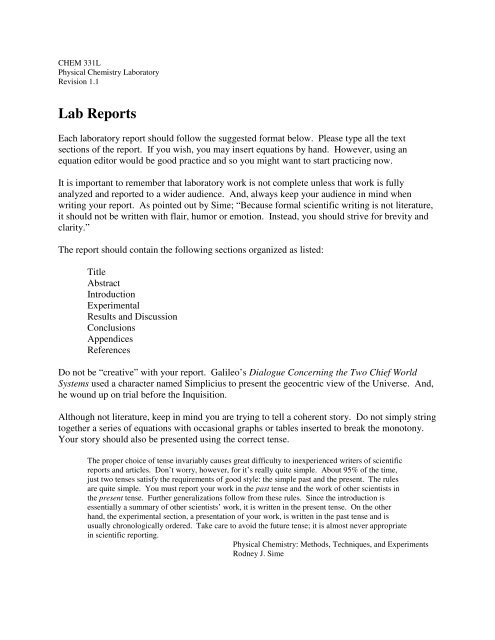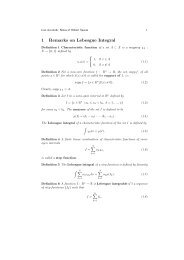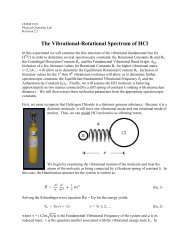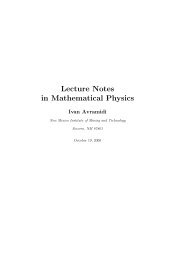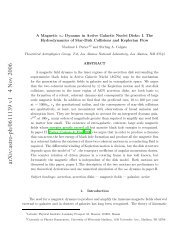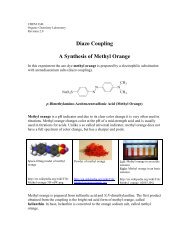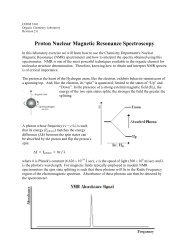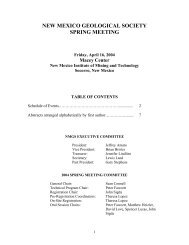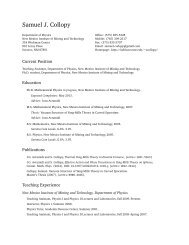Format for Lab Reports
Format for Lab Reports
Format for Lab Reports
Create successful ePaper yourself
Turn your PDF publications into a flip-book with our unique Google optimized e-Paper software.
CHEM 331LPhysical Chemistry <strong>Lab</strong>oratoryRevision 1.1<strong>Lab</strong> <strong>Reports</strong>Each laboratory report should follow the suggested <strong>for</strong>mat below. Please type all the textsections of the report. If you wish, you may insert equations by hand. However, using anequation editor would be good practice and so you might want to start practicing now.It is important to remember that laboratory work is not complete unless that work is fullyanalyzed and reported to a wider audience. And, always keep your audience in mind whenwriting your report. As pointed out by Sime; “Because <strong>for</strong>mal scientific writing is not literature,it should not be written with flair, humor or emotion. Instead, you should strive <strong>for</strong> brevity andclarity.”The report should contain the following sections organized as listed:TitleAbstractIntroductionExperimentalResults and DiscussionConclusionsAppendicesReferencesDo not be “creative” with your report. Galileo’s Dialogue Concerning the Two Chief WorldSystems used a character named Simplicius to present the geocentric view of the Universe. And,he wound up on trial be<strong>for</strong>e the Inquisition.Although not literature, keep in mind you are trying to tell a coherent story. Do not simply stringtogether a series of equations with occasional graphs or tables inserted to break the monotony.Your story should also be presented using the correct tense.The proper choice of tense invariably causes great difficulty to inexperienced writers of scientificreports and articles. Don’t worry, however, <strong>for</strong> it’s really quite simple. About 95% of the time,just two tenses satisfy the requirements of good style: the simple past and the present. The rulesare quite simple. You must report your work in the past tense and the work of other scientists inthe present tense. Further generalizations follow from these rules. Since the introduction isessentially a summary of other scientists’ work, it is written in the present tense. On the otherhand, the experimental section, a presentation of your work, is written in the past tense and isusually chronologically ordered. Take care to avoid the future tense; it is almost never appropriatein scientific reporting.Physical Chemistry: Methods, Techniques, and ExperimentsRodney J. Sime
Because you are telling a story, do not interrupt the flow of the narrative with lengthy Tables orGraphs. Shorter tables and graphs can be inserted into the text of the report. Those that are moreinvolved should be included in appropriate Appendices. Even though they are presented in anAppendix, the report’s narration should refer to these graphs and tables as well as their purpose.Tables should include a descriptive and in<strong>for</strong>mative title, with each column also titled, and eachshould be provided with a number. Each column title should include appropriate units ofmeasurement. Any variables used in titles should be fully defined within the body of the labreport. Tabulated numerical data should also include error estimates.Graphs should also be titled descriptively and be numbered. A title such as Density vs.Concentration is not descriptive. Something more appropriate might be Density of AqueousEthanol Solutions at 25 o C. Each of the graph’s axes should be labeled along with units ofmeasurement. Each data point should be distinctively marked and should include an error bar. Ifmultiple data sets are included on a single graph, each set should have a different marking and alegend of the markings should be provided. Graphs should be scaled so the bulk of the area isused <strong>for</strong> presenting data. Appropriate trendlines should be included along with a least squaresanalysis of the trendline equation parameters.What follows are some details concerning each of the above mentioned report sections. I presentan example drawn from the literature <strong>for</strong> most of these sections. Pay attention to not only whatis said in each example, but how it is said. Different Journals require different styles ofpresentation. All of the examples presented below are drawn from the Journal of PhysicalChemistry.TitleAppropriately title the lab report. The title should be fully descriptive of the presentation youwill be making. Don’t simply title a report Surface Tension Measurements. This begs thequestion; surface tension measurements of what? Something more appropriate might be TheSurface Tension of Aqueous n-Butanol.AbstractThis is a very, very short description of the experiment completed. It should not exceed threesentences in length. It should answer the following three questions:i) What was measured or determined?ii) How was the measurement per<strong>for</strong>med?iii) What were the results?Only one or two key numeric results should be presented at this point. Any numeric resultspresented, however, should also include an error estimate.
The following example is fairly well written.What was determined: second hyperpolarizabilities. How were they determined: they were “calculated”.(A modeling program was used.) Some verbiage is also presented concerning the general results.IntroductionBegin with a short description of the purpose of the experiment and the relevant theory involved.Key equations to be used in the analysis should be presented in this section. Define all symbolsused in these equations; unless they are defined in the lab handout. This section should providean overview of the experiment and the key results to be determined.Notice how, in the following example, the author proceeds from generally applicable theory tospecifics concerning what will be presented in subsequent sections of the report......
ExperimentalProvide a descriptive narration of the experimental procedure. This should be given in the pasttense as it is a description of things already done. It should follow the logical order in which theexperiment was carried out.Include relevant in<strong>for</strong>mation concerning any specialized apparati, the chemicals used and howexperimental variables were controlled. Do not simply regurgitate the published procedure.This should be a description of the procedural steps you actually per<strong>for</strong>med. Although it shouldalso be short, it should contain all the specifics needed <strong>for</strong> an independent experimenter to repeatthe experiment. Include error estimates <strong>for</strong> all experimental data. Do not include details ofprocedures that are considered common place in the chemical laboratory. Be as concise aspossible.Again, the example should be studied carefully.
Results and DiscussionHere is the point at which you will include important experimental observations, keyexperimental results along with their error estimates and any deviations from the publishedprocedure. Include tables of data, where relevant, and all calibration curves generated.Then, present and discuss the results of your data analysis. This should be presented in a logicalorder; starting with your first calculated results and proceeding to those calculations that build onthese results. Provide sufficient narration that the reader can follow the flow of the arguments.Do not simply provide a string of data calculations without any rationale <strong>for</strong> why they are beingper<strong>for</strong>med. However, do not become chatty and verbose.If graphs or tables are used, refer to them in your narration. Include some verbiage as to what islearned from their presentation.All calculations should include:i) One relevant sample calculation; all subsequent repetitive calculations should beomitted. Results of repetitive calculations should simply be tabulated.ii) Equations used should be presented in their general <strong>for</strong>m, followed by a single caseinto which data, along with units, are inserted.iii) All results should include corresponding units.iv) Each calculation should be followed by an appropriate error analysis. The <strong>for</strong>mat <strong>for</strong>presenting error analysis calculations is the same as that described <strong>for</strong> othercalculations.If computer programs are used <strong>for</strong> data reduction, a sample calculation, with error analysis,should be presented here. A program listing <strong>for</strong> any specialty software used in the data reductionshould be included in an Appendix. Complete software output should also be included in anAppendix.Note the narrative style of the example.
Because this is a laboratory report, and not a paper to be submitted <strong>for</strong> publication, some detailconcerning calculations should be provided. For example, a calculation of the acceleration dueto gravity from pendulum measurements might be presented as:g = 4π 2 l / T 2 = 4 π 2 (1.00 m) / (2.00 sec) 2 = 9.9 m/sec 2Errors in the measurement of l and T were estimated based on repeated observations of thesame system. A maximum error estimate of g is thus:∆g = (4π 2 /T 2 ) ∆l + (8π 2 l/T 3 ) ∆T= (4 π 2 / (2.00 sec) 2 ) (0.01 m) + (8 π 2 (1.00 m) / (2.00 sec) 2 ) (0.02 sec)= 0.3 m/sec 2The error estimate should never be reported with more than one or two digits. Also, the precision of thecalculated result should match the precision of the error estimate.
ConclusionSum up your experiment and the derived experimental results. Compare your results with thoseof the literature. Consider experimental sources of error. Discuss how these errors might bereduced or how the experiment might be improved upon.In general, the conclusion should reverse the point of view of the introduction. Start withspecifics concerning your experiment and proceed to a more general discussion.......ReferencesSources cited or used, other than the experimental procedure provided in class, should beappropriately referenced.


